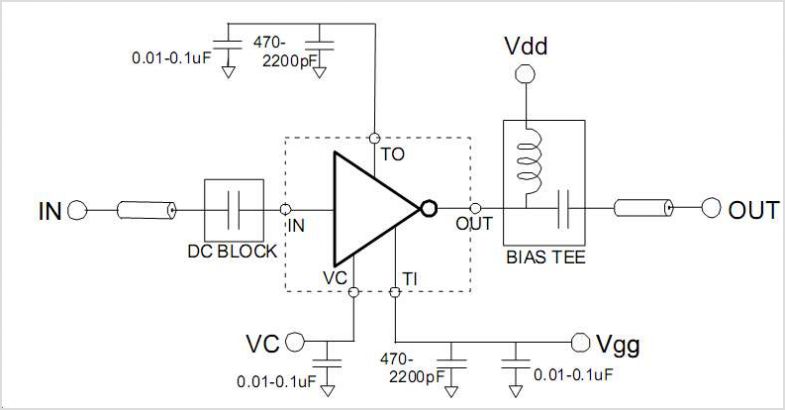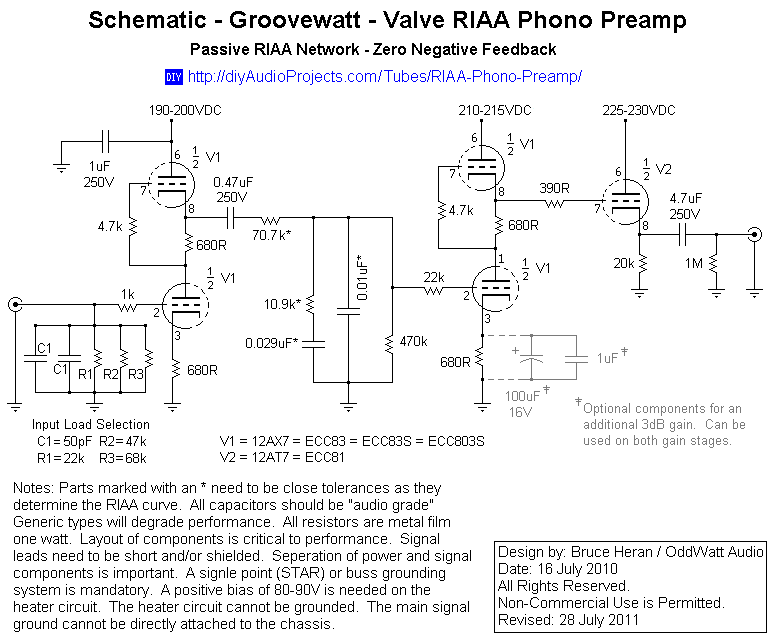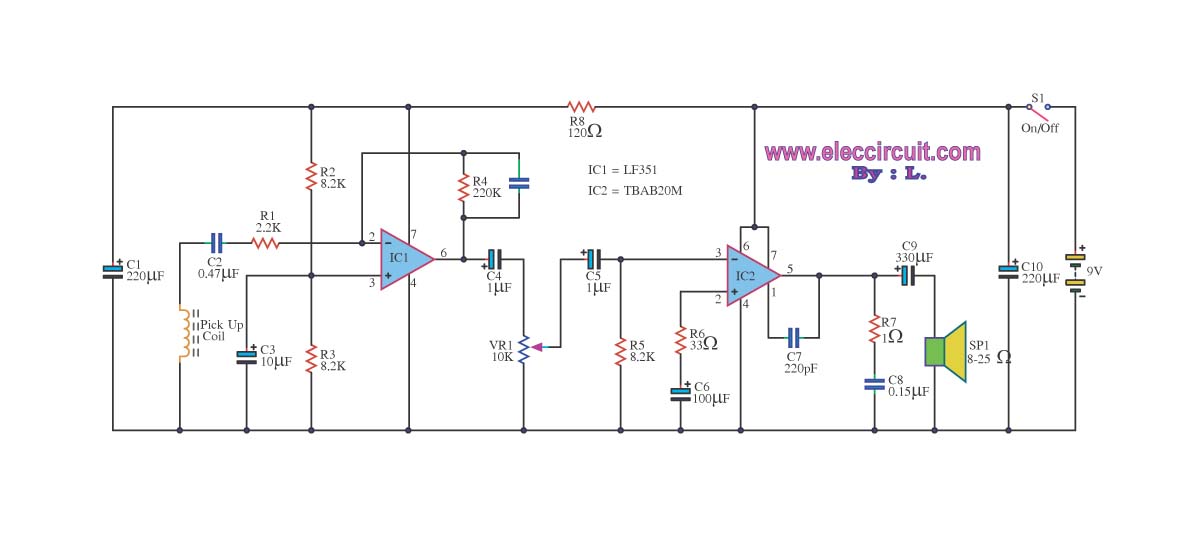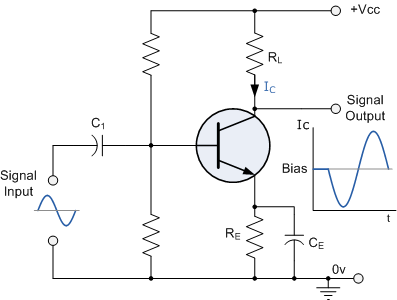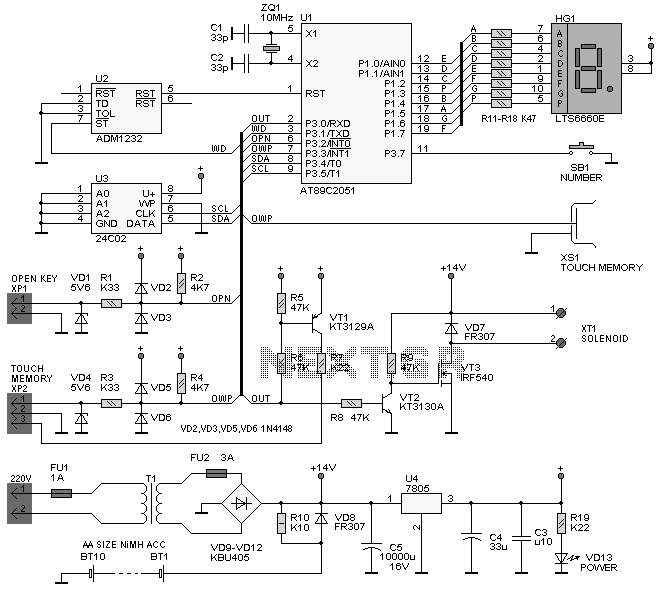
2W Amplifier

Designed for self-powered 8, 4 & 2 Ohm loudspeakers. This amplifier was designed to be self-contained in a small loudspeaker box. It can be fed by Walkman, Mini-Disc, iPod and CD players, computers and similar devices fitted with line or headphone output. Of course, in most cases, you will have to make two boxes to obtain stereo. Bass-boost switch. More: The circuit was deliberately designed using no ICs and in a rather old-fashioned manner in order to obtain good harmonic distortion behavior and to avoid hard-to-find components. The amplifier(s) can be conveniently supplied by a 12V wall plug-in adapter.
The described amplifier circuit is intended for use with self-powered loudspeakers, specifically accommodating impedances of 8, 4, and 2 Ohms. Its design emphasizes a compact form factor, allowing it to be integrated into a small loudspeaker enclosure, which is suitable for various portable audio sources such as Walkman devices, Mini-Disc players, iPods, CD players, and computers. The input compatibility with line or headphone outputs makes it versatile for modern audio devices.
The amplifier circuit is notable for its absence of integrated circuits (ICs), opting instead for a more traditional, discrete component approach. This design choice is aimed at achieving favorable harmonic distortion characteristics while also ensuring that the components used are readily available and easy to source. The use of discrete components can enhance the sound quality due to the inherent linearity and simplicity of the circuit, which can lead to a more natural audio reproduction.
A bass-boost switch is included in the design, allowing users to enhance low-frequency response, which can be particularly beneficial in smaller loudspeaker systems where bass reproduction may be limited. This feature provides flexibility for the listener to adjust the audio output to suit personal preferences or specific listening environments.
Powering the amplifier is straightforward, as it can be connected to a 12V wall plug-in adapter, ensuring a stable and sufficient power supply for the operation of the amplifier and the connected loudspeakers. The design encourages the construction of two amplifier boxes for stereo sound, enhancing the listening experience by providing a left and right audio channel.
Overall, this amplifier circuit stands out for its simplicity, ease of assembly, and focus on sound quality, making it an ideal choice for DIY audio enthusiasts looking to create a compact and effective loudspeaker system.Designed for self-powered 8, 4 & 2 Ohm loudspeakers. This amplifier was designed to be self-contained in a small loudspeaker box. It can be feed by Walkman, Mini-Disc, iPod and CD players, computers and similar devices fitted with line or headphone output. Of course, in most cases you will have to make two boxes to obtain stereo. Bass-boost switch. The circuit was deliberately designed using no ICs and in a rather old-fashioned manner in order to obtain good harmonic distortion behavior and to avoid hard to find components. The amplifier(s) can be conveniently supplied by a 12V wall plug-in adapter. 🔗 External reference
The described amplifier circuit is intended for use with self-powered loudspeakers, specifically accommodating impedances of 8, 4, and 2 Ohms. Its design emphasizes a compact form factor, allowing it to be integrated into a small loudspeaker enclosure, which is suitable for various portable audio sources such as Walkman devices, Mini-Disc players, iPods, CD players, and computers. The input compatibility with line or headphone outputs makes it versatile for modern audio devices.
The amplifier circuit is notable for its absence of integrated circuits (ICs), opting instead for a more traditional, discrete component approach. This design choice is aimed at achieving favorable harmonic distortion characteristics while also ensuring that the components used are readily available and easy to source. The use of discrete components can enhance the sound quality due to the inherent linearity and simplicity of the circuit, which can lead to a more natural audio reproduction.
A bass-boost switch is included in the design, allowing users to enhance low-frequency response, which can be particularly beneficial in smaller loudspeaker systems where bass reproduction may be limited. This feature provides flexibility for the listener to adjust the audio output to suit personal preferences or specific listening environments.
Powering the amplifier is straightforward, as it can be connected to a 12V wall plug-in adapter, ensuring a stable and sufficient power supply for the operation of the amplifier and the connected loudspeakers. The design encourages the construction of two amplifier boxes for stereo sound, enhancing the listening experience by providing a left and right audio channel.
Overall, this amplifier circuit stands out for its simplicity, ease of assembly, and focus on sound quality, making it an ideal choice for DIY audio enthusiasts looking to create a compact and effective loudspeaker system.Designed for self-powered 8, 4 & 2 Ohm loudspeakers. This amplifier was designed to be self-contained in a small loudspeaker box. It can be feed by Walkman, Mini-Disc, iPod and CD players, computers and similar devices fitted with line or headphone output. Of course, in most cases you will have to make two boxes to obtain stereo. Bass-boost switch. The circuit was deliberately designed using no ICs and in a rather old-fashioned manner in order to obtain good harmonic distortion behavior and to avoid hard to find components. The amplifier(s) can be conveniently supplied by a 12V wall plug-in adapter. 🔗 External reference

